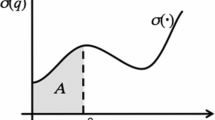Abstract
We consider a discrete-time dynamic game in which a finite number of players extract a non-renewable resource and derive consumption solely from the extracted amount (cake-eating game). Markov perfect Nash equilibria consisting of linear strategies can be constructed in this game not only if the players have time-preference factors that are smaller than 1, but also if these factors are equal to or even larger than 1. We demonstrate this result both for the case of identical players and for the case of heterogeneous players. In addition, we study the influence of the model parameters on the equilibrium.


Similar content being viewed by others
Notes
Note that we define the property of being a MPNE only for feasible strategy profiles, i.e., for profiles satisfying condition (3). Sundaram [10] uses an ad hoc rule to determine the consumption rates for infeasible strategy profiles. The important point is that there is no way to place conditions on the primitives of the model that guarantee that a strategy profile will always be feasible.
Later in this section, we shall discuss the model without discounting.
For the parameter set \((\alpha _1,\alpha _2,\rho _1,\rho _2)=(2/3,1/4,1.05,1.05)\) there does not exist a MPNE consisting of linear strategies.
References
Barro RJ (1974) Are government bonds net wealth? J Pol Econ 82:1095–1117
Clemhout S, Wan H (1989) On games of cake-eating. In: van der Ploeg F, de Zeeuw AJ (eds) Dynamic policy games in economics. North-Holland, Amsterdam, pp 121–155
Dutta PK, Sundaram R (1992) Markovian equilibrium in a class of stochastic games: existence theorems for discounted and undiscounted models. Econ Theory 2:197–214
Gale D (1967) On optimal development in a multi-sector economy. Rev Econ Stud 34:1–18
Kemp MC, Long NV (eds) (1980) Exhaustible resources, optimality and trade. North-Holland, Amsterdam
Levhari D, Mirman LJ (1980) The great fish war: an example using a dynamic Cournot–Nash solution. Bell J Econ 11:322–334
Long NV (2011) Dynamic games in the economics of natural resources: a survey. Dyn Games Appl 1:115–148
Mitra T, Sorger G (2014) Extinction in common property resource models: an analytically tractable example. Econ Theory 57:41–57
Salo S, Tahvonen O (2001) Oligopoly equilibria in nonrenewable resource markets. J Econ Dyn Control 25:671–702
Sundaram R (1989) Perfect equilibrium in a class of symmetric dynamic games. J Econ Theory 47:153–177
Weitzman ML (2007) A review of the Stern review on the economics of climate change. J Econ Lit 45:703–724
Acknowledgments
The authors are grateful for the detailed and constructive comments of an anonymous referee.
Author information
Authors and Affiliations
Corresponding author
Rights and permissions
About this article
Cite this article
Mitra, T., Sorger, G. Noncooperative Resource Exploitation by Patient Players. Dyn Games Appl 5, 361–377 (2015). https://doi.org/10.1007/s13235-015-0135-5
Published:
Issue Date:
DOI: https://doi.org/10.1007/s13235-015-0135-5
Keywords
- Non-renewable resource
- Common property resource
- Dynamic game
- Patient players
- Markov perfect Nash equilibrium




